Medium late variety of onions with very large heads "Exhibitive"
More than a hundred varieties of onions are found in the garden plots. Some growers prefer old, proven crops, while others experiment with new products. At the same time, the advantages of the Exibishen variety are recognized by both. It is high yielding, suitable for growing in all regions. Large sweet onions are especially valuable.
The content of the article
What is this grade
Exibition - salad variety, the bulbs of which are consumed in pure form.
Origin and development
This medium late onions were bred in Holland seed company "Bejo Zaden".
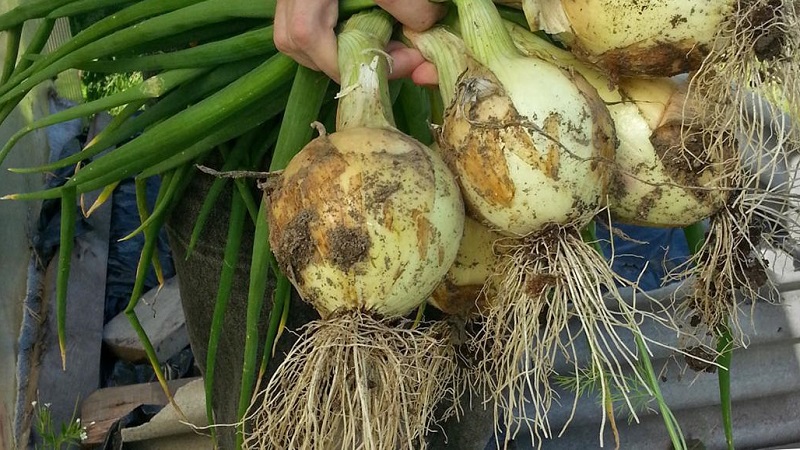
Composition and useful properties
Vegetable culture has a rich chemical composition:
- B vitamins, which have a beneficial effect on the health of skin, nails and hair, support metabolism and brain function;
- vitamin E with antioxidant properties;
- vitamin C, which increases immunity;
- vitamin PP, which normalizes the amount of sugar and cholesterol in the blood;
- fiber, which cleanses the body of toxins and toxic substances;
- essential oils and organic acids;
- macro- and microelements: zinc, iodine, iron, potassium and others, which support the work of the endocrine, cardiovascular and nervous systems, metabolism.
The composition of the bow does not change after heat treatment.
Ripening terms
From emergence of mass shoots to harvest onion Exibition lasts an average of 4 months.
Yield
Subject to the rules of agricultural technology, the variety is highly productive: its marketable yield - up to 4.5 kg / m2.
Disease resistance
Under certain conditions (high humidity, sudden changes in temperature) Exibition is capable of getting sick onion smut, rot, peronosporosis.
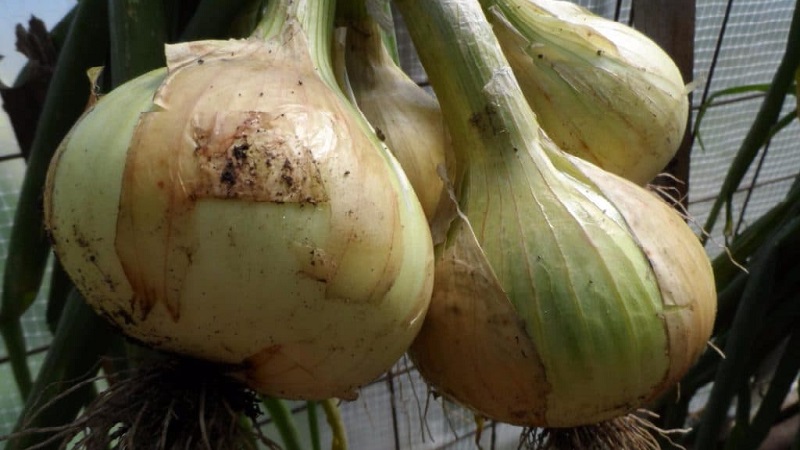
Specifications
The main feature of the variety is the size of the bulbs. Each weight is 170-550 g. Often there are giant specimens weighing up to 800 g. The vegetables themselves are slightly oblong, smooth, light yellow on the outside. The juicy scales are white. The husk is thin and tight. The onion tastes sweet and juicy, without bitterness.
For which regions is it suitable
Exibishen does not tolerate low temperatures, but is approved for cultivation throughout the country... It is planted in greenhouses regardless of the weather, but in open ground only after the ground has warmed up enough. In most regions of Russia, this is the second half of April.
In Siberia, the Urals and in more northern latitudes, mid-May is expected in order not to freeze the plants. Even then, it is better to prepare small arches above the garden bed in order to protect the planting in case of frost.
Other varieties of onions:
Advantages and disadvantages of the variety
The virtues of culture:
- high productivity;
- large bulbs;
- pleasant sweetish taste of vegetables;
- good transportability in small containers;
- the possibility of disembarkation both in spring and before winter.
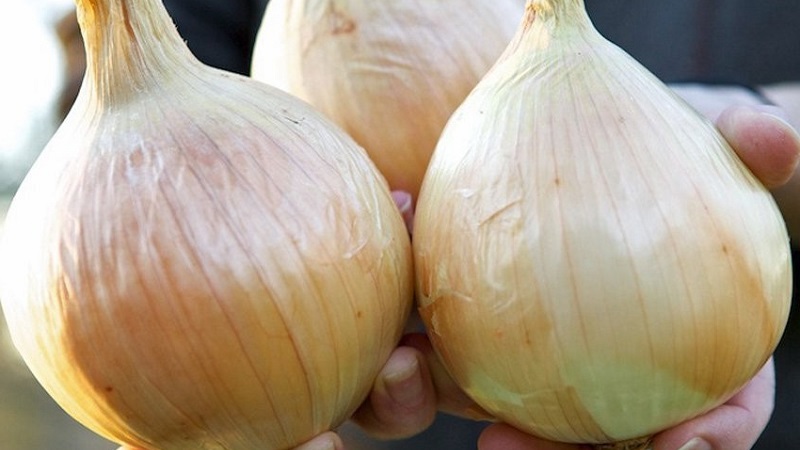
There are also disadvantages:
- short shelf life: onions are prone to sprouting;
- exactingness to nutrition, watering and certain growing conditions;
- the need to treat plantings with pesticides against pests and diseases.
Sometimes the large size of the bulbs is also considered a disadvantage.
Difference from other varieties
A characteristic feature of the Exibishen variety - large size and sweet taste of the bulbs. Due to the content of essential oils when cutting, the vegetable does not irritate the mucous membranes of the eyes.
Features of planting and growing
They buy seed only in specialized stores and from trusted sellers.
Preparing for landing
It depends on proper preparation and adherence to the rules of growing the quality of the future harvest.
Important! Exhibishen onions are planted in open ground with seedlings, the optimal sowing time is at the end of February.

Seeds are prepared for seedling growing in stages:
- Calibrate.
- Disinfected in a weak solution of potassium permanganate for 20 minutes.
- Soaked in a growth promoter.
- They are washed with warm water and laid out on a damp cloth for 2-3 days for germination.
- Dry a little.
Seedling boxes are filled with a mixture of black soil, peat and compost. In wet soil, long grooves are made at a distance of 2 cm from each other, one seed is planted every 1.5 cm, sprinkled with earth. The container is covered with foil, put in a warm place and await the emergence of seedlings.
Water the seedlings as the top soil layer dries... When the third leaf is formed, the seedlings are shortened, leaving only 1/3 of the feather length. Two weeks before the dive into the open ground, the onion is hardened by bringing it to a cooler room for 15–20 minutes. Gradually, the time is increased to two hours.
Ground requirements
The future harvest suffers greatly from an incorrectly selected site. A place for a garden bed is chosen on the sunny side. The soil must be nutritious and non-acidic... Since autumn, phosphorus-potassium fertilizers and humus have been introduced into it, they dig everything deeply.
Read also:
Terms and rules of landing
In the formed bed, holes are made according to the scheme 20 * 30 cm, they put ash and superphosphate in them. Lumps of earth are inserted into the holes together with seedlings to a depth of 2-3 cm. The plants are sprinkled with earth on top, moistened. The site is covered with a film.
Specific landing dates depend on the region and its climatic conditions. The main thing is that the earth warms up to + 10 ° C.
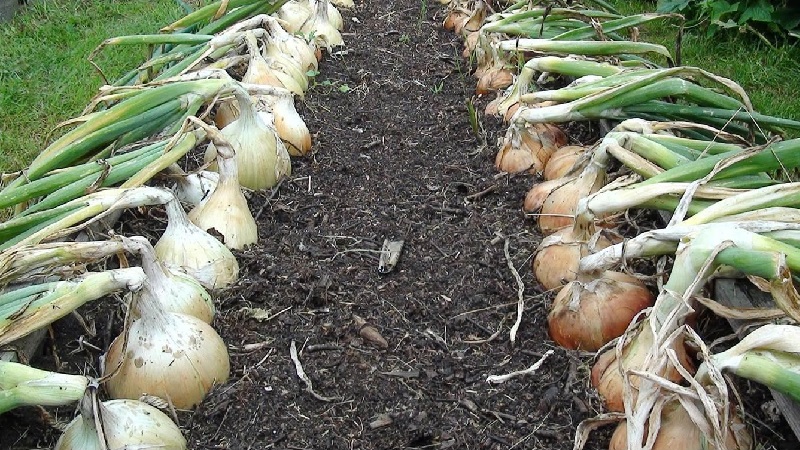
Growing features
When cultivating onions before winter, the beds are insulated straw, sawdust, dry mullein. As soon as the snow melts in the spring, the mulch is removed. In the south, such a shelter is not made, since the soil rarely freezes.
The nuances of care
Exibition is picky about leaving... He needs constant loosening, weed and pest control, watering and fertilizing.
Watering mode
On average, onion beds are watered once every 15-20 days in the evening... In the dry season, planting is irrigated every other day.
Attention! Only warm water is used.
About a month before harvesting, watering is stopped.
Loosening and weeding
After moistening, the beds are loosenedwithout touching roots and bulbs. The beds and aisles are kept clean, regularly weeding from weeds.
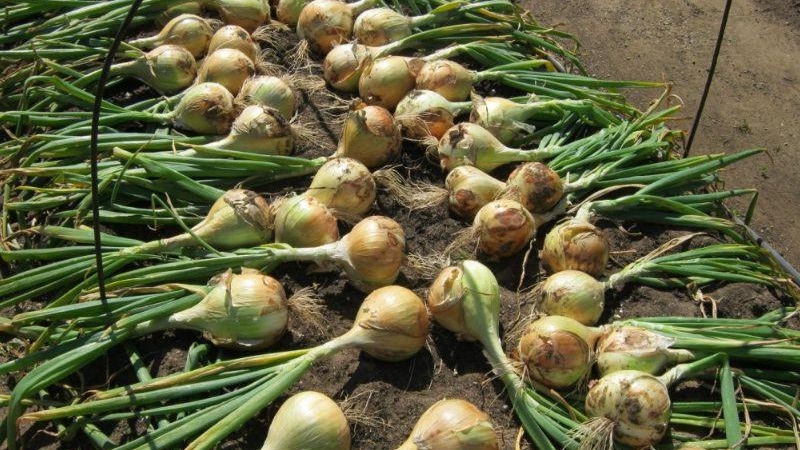
Top dressing
Fertilize the culture every 2-3 weeks... 20 days after disembarkation, a mullein solution is introduced (one bucket for 15 buckets of water) with 1 tbsp. l. superphosphate per one bucket of the mixture. After another three weeks, complex mineral fertilizers are used. A month before harvesting, all feeding is stopped.
Disease and pest control
The variety is prone to such diseases, like rot, onion smut, peronosporosis. Of the pests, the nematode and onion fly are dangerous.
For prevention, they observe the watering regime, monitor the planting density, vegetables are treated with insecticides and biological agents. The beds are sprinkled with lime flour or a mixture of tobacco, pepper and ash. The onion fly is scared away by marigolds and nasturtiums planted along the perimeter of the site.
Attention! Planting is treated with chemicals only if feathers are not used for food.
Harvesting and storage
Despite the fact that the variety has a low keeping quality, it is important to follow the basic rules for harvesting and storing the crop so that the efforts made are not in vain.
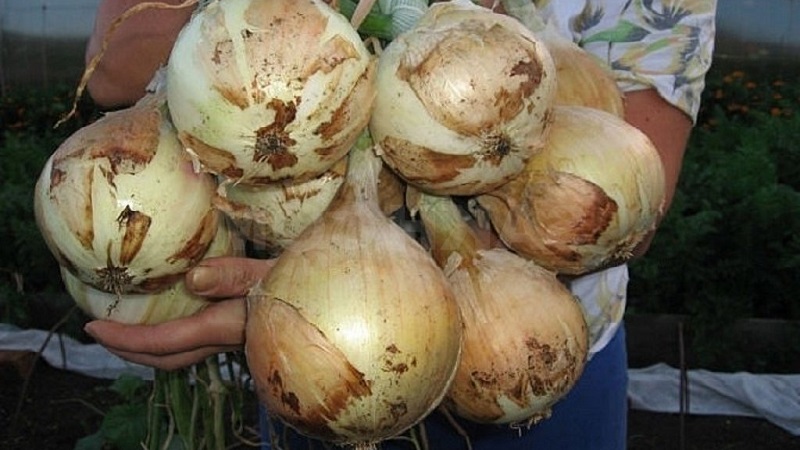
How and when to collect
Harvesting times for Exibition onions vary by region. In Siberia or the Urals, this is done at the end of August-September. In warmer latitudes - in July and early August.
Reference. If the feathers turn yellow and lay on the ground, the onion is ready to harvest.
Vegetables are removed from the ground in dry weather, since they are dried in the sun for several days. Then transferred to a ventilated room and continue to dry. The entire procedure takes up to three weeks. The shelf life depends on how well the onion dries. In dried vegetables, the feathers are cut off, leaving a high neck.
The main signs that the onion is ready for storage:
- the husk has become smooth and rustling;
- the neck is dry;
- the surface of the vegetables is firm and dry.
Storage features and keeping quality
Maximum the shelf life of Exhibishen onions is no more than four months... Therefore, the room creates optimal storage conditions:
- good air circulation;
- temperature - about + 4 ° C;
- air humidity - 70% (in dry air, the onion will wilt, in humid air it rots).
Good basement or cellar suitable.
Store onions in small hanging nets either in baskets or boxes of ash. Many braid it in pigtails or fold it into nylon stockings.
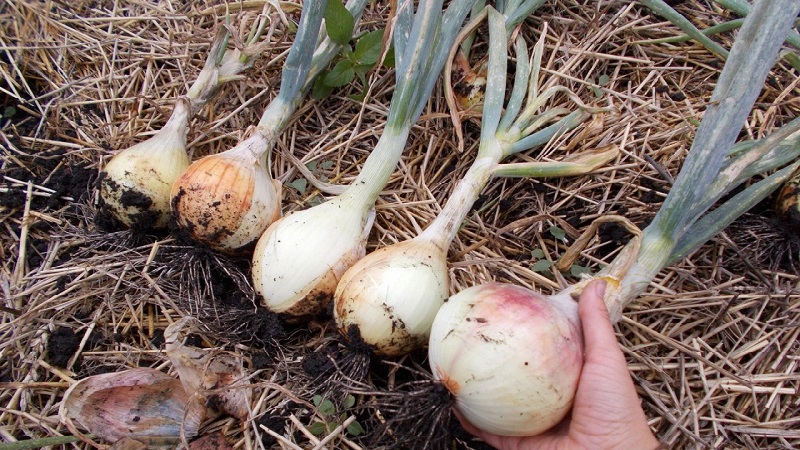
Growing difficulties
Cultivation of the Exibishen variety from seed and soil preparation to harvest storage requires constant monitoring of the grower. It is important to monitor the seedlings, water them regularly, remove diseased plants on time, sort out the harvested onions so as not to miss spoiled specimens.
Tips from experienced gardeners
Experienced farmers who have been growing this variety for several years recommend:
- alternate onion beds with carrot beds: this will protect the planting from onion flies;
- plant a crop where watermelons, melons, pumpkins, zucchini or peas were previously grown;
- create drainage in the area so that the liquid does not stagnate.
Reviews
Onion Exibishen pleases farmers with its size, taste and presentation, high productivity. Some note different seed germination depending on the firm.
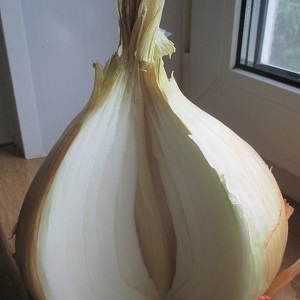 Akulina, Iskitim: “For the fifth year now, I have been planting Exhibishen onions in my garden from Planet Seed. I met this variety by chance: my daughter bought 2 bags in one of the stores. When I read the description and looked at the picture, I decided it was just an advertisement. But since there are seeds, you have to plant them.
Akulina, Iskitim: “For the fifth year now, I have been planting Exhibishen onions in my garden from Planet Seed. I met this variety by chance: my daughter bought 2 bags in one of the stores. When I read the description and looked at the picture, I decided it was just an advertisement. But since there are seeds, you have to plant them.
Grown for seedlings, as the manufacturer advises. I was very pleased with the 100% germination rate. The sprouts were all preserved and did not hurt at all. To make the bow larger, the feather did not pluck from it. Culture ripened early. I was very surprised and delighted with the abundant harvest. The fruits are just gigantic! I had copies from 500 g. The onion is tasty and not bitter, preserved until the New Year. When I found out what it is useful for, I wanted to grow only this variety ".
Svetlana, Yurga: “I bought a package of Exhibitive seeds, and at the end of February began to grow them for seedlings. Planted in the ground in early May. I cut off the roots by 1/3 and the upper part of the plants. Further care: weeding, watering and mulching with humus. The harvest was good. The bulbs, as they say, are of a presentation. The description of the variety and the photo on the package correspond to reality. The taste did not disappoint either ".
Elena, Moscow: “I read the rave reviews about Exhibishen onion seeds from Aelita - I decided to grow it for the first time this year. I followed all the care requirements, but only 5 sprouts emerged from three sachets. I will plant onions again, but I will not buy Aelita seeds ".
Conclusion
The Exibischen onion attracts vegetable growers with its size and sweet taste without bitterness. It will perfectly complement any dish, especially during the cold season.Subject to all the rules of cultivation, Exibishen gives a rich harvest that will last at least until mid-winter.